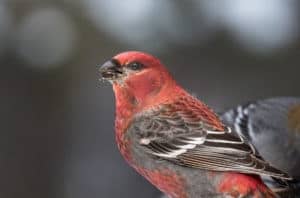Species Spotlight: Pine Grosbeak
Dec 22, 2016 | by Kevin Loughlin

Pine Grosbeak (Male)
The boreal forests of North America are full of amazing landscapes and wildlife. Viewing wildlife in these areas often means freezing temperatures. While not exactly the most favorable conditions for us humans to be exposed to for long periods of time, many animals flourish in the cold weather.
At 8-10 inches long, the Pine Grosbeak is one of the largest finches on the planet. When I first laid eyes on this bird, I was astounded at the size, imagining them being far smaller than they actually were. Males are easily identified by their beautiful reddish pink feathers. While females are much more gray in color, they have brilliant spots of yellow on their heads, breast, and at the base of the tail.
For the most of year, their diets consist mainly of buds, seeds, and fruits of spruce, pine, juniper, elm, maple, mountain ash, apple, and crabapple trees. They frequent bird feeders to feast on the seeds provided within, and are quite tame much of the time. These birds possess a lot of character and are a blast to watch. While observing a group in northern Minnesota, I watched them play in the snow and chase each other around feeders.
Seeing the largest and rarest of the winter finches is something that every birder should experience at least once. Spending time in the northern forests is often a surreal experience, and seeing the Pine Grosbeak is an unforgettable experience. Their winter range extends to many of the northern states. If you’d love to see this bird and many other amazing boreal species, consider joining Greg Miller on his Big Year Series: Winter Owls trip coming up in February! As many as seven species of owl have been seen during peak irruption seasons, and you’ll have a good chance at seeing many of the other amazing boreal species including Black-backed Woodpecker, Evening Grosbeak, Boreal Chickadee, Gray Jay, and of course, the Pine Grosbeak!
































